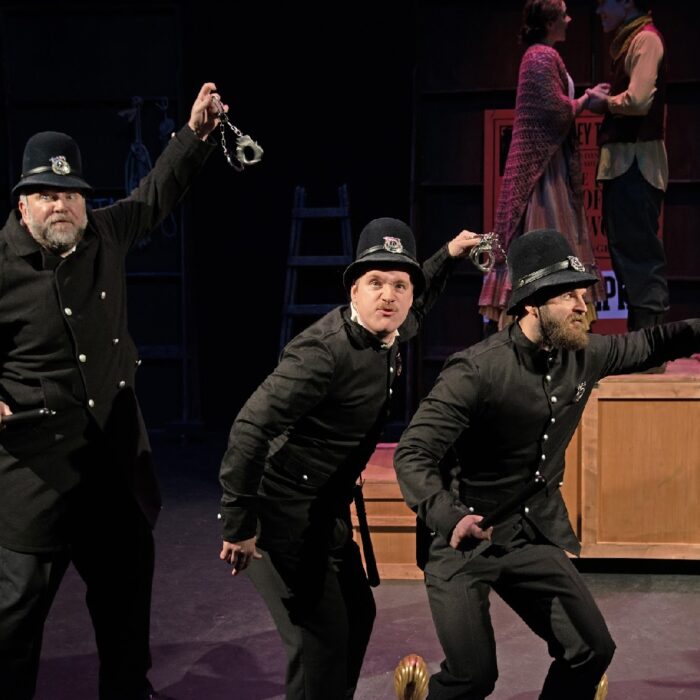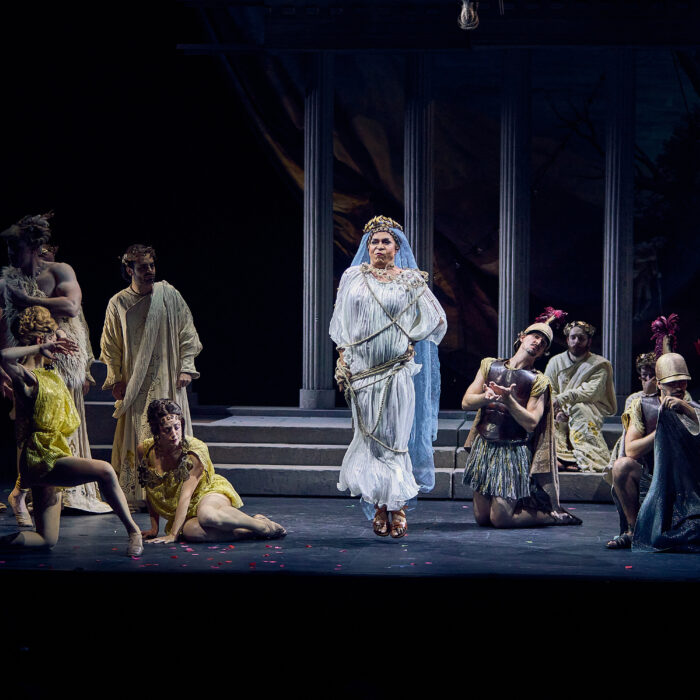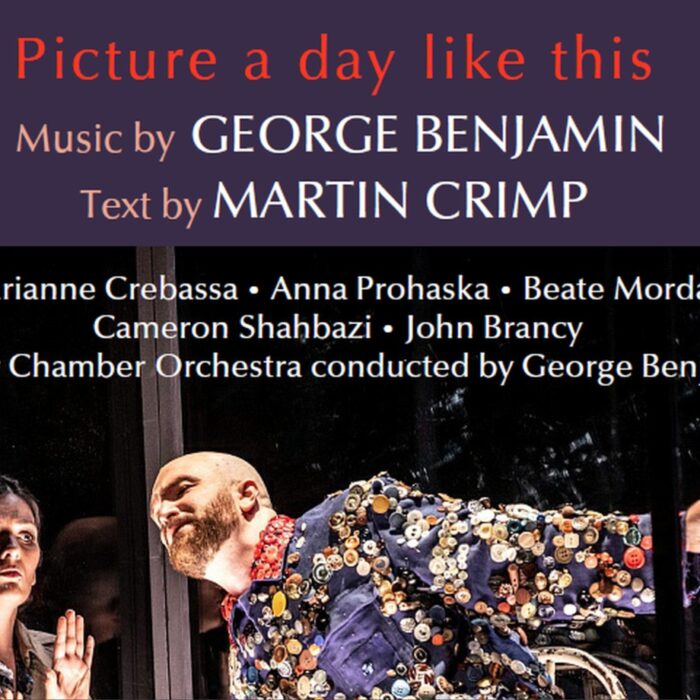
San Francisco Opera 2021-22 Review: Fidelio
Elza van den Heever & Russell Thomas Lead Wondrous Rendition of Beethoven’s ‘Cri de Coeur’
By Lois Silverstein(Credit: Cory Weaver/San Francisco Opera)
The talisman of Beethoven’s “Fidelio” is “Freiheit (freedom).” Though “Fidelio” is Beethoven’s only opera, it was not his only “cri de coeur” for liberty as the conclusion of his Ninth Symphony showed.
San Francisco Opera’s production offered that message for today’s world. “Freiheit” equals Liberty. “Freiheit” equals independence, both personal and political. And “Freiheit” equals the struggle for justice. In SFO’s production, none of this could be missed. When the curtain came down, not only did we walk away with what one of my companions called, “a very San Francisco performance,” but we also half-expected to hear the “Ode to Joy” burst from the chorus.
American director Matthew Ozawa’s production centers on the message of freedom, and the ease with which it can be lost. The stage-size, steel-constructed prison, modern government detention center, and the masterful use of audio-visual effects create a socially dark and corrupt atmosphere in every way.
Liberators
Beethoven’s revolutionary opera symbolizes the human quest for righting injustice, and all aspects of the production aim to illustrate that. The plot’s lynchpin is the heroic act of a woman, Leonore/Fidelio, to free her husband, Florestan, from unjust imprisonment.
Ozawa setting looks beyond Florestan, highlighting the myriads of others wrongly incarcerated. Further, the production, and the opera itself, foreground the perfect operatic contest between good and evil, love and hate, and darkness and light.
Soprano Elza van den Heever sang the heroine Leonore/Fidelio, making her long-awaited return to San Francisco. Van den Heever sang with ardor and luster, her voice tender and filled with longing in early scenes. When she sheds her disguise in Act two, revealing herself to be Leonore, her voice was full of passion and heroism.
In Act one, Van den Heever assumes the identity of the security guard, Fidelio, a sturdy, hard-working male who fends off the advances of Marzelline sung by Anne-Marie MacIntosh. Marzelline, meanwhile, has the jailer Rocco’s assistant, Jaquino, (played by Christopher Oglesby), to keep at bay as he pleas for her hand in marriage. The irony works well in foreshadowing the different love reflected in Florestan and Leonore that’s sacrificial, deeply kind, and generous—a far cry from office flirtation. It’s their love that, in the end, takes center stage.
By Act two, Van den Heever’s vocal and physical energy surged. She embodied Leonore’s determination to save Florestan in her actions and the power of her voice, which was sinuous and rich, as she sang of her courage to go to any lengths to free her beloved. When she drops the Fidelio disguise, she liberates both herself and Florestan from all layers of imprisonment, repudiating separation, injustice, and false accusation.
Tenor Russell Thomas portrayed Florestan, the imprisoned political dissident, and Leonore’s husband with strength and power. Thomas has received wide acclaim for his Florestan, with other critics noting his clarion tenor sound, as well as how gives all he has to present a man “in extremis.” Here we were witness to the same passion.
Chained hand and foot to a chair in the bowels of the detention center, he emerges from the darkness with the powerful cry of, “Gott (god),” sustaining the note with ardent power. That alone was worth the performance. Thomas continued the aria with exquisite steadiness and beauty that cut through the darkness like a fine-edged sword. Florestan’s singular human cry was for himself and all the prisoners within the surrounding cells. When Leonore/Fidelio rescues Florestan, she saves the others as well.
Thomas sang Florestan’s “Welch dunkel hier (What darkness here)” with appropriate pianissimo, although it seemed a bit more muffled than a quiet afterthought. The rest of the aria also, while plangent, seemed too languid. Some of this came, no doubt from his being chained to the chair, rendering him unable to move or express himself fully.
Dream Project
The moments of recognition between husband and wife were the most moving moment of the two acts. While it takes longer for Florestan to recognize his wife than seems credible, when it happens, everything falls into place. With that recognition, social and moral order comes along with it. Harmony and peace dissolve persecution, punishment, brutality, and injustice. Florestan and Leonore’s duet restores on many levels as chains are removed, physical movement permitted, and their love regenerated.
Call it romantic, call it revolution; it was the source of so much power. Every action that led to confinement and constriction had to be parsed and eliminated. Bass-baritone Greer Grimsley’s Don Pizzaro appears slick and smooth when he arrives on the balcony to sing of his tyrannical corruption with pride and irony, but that will soon be dismantled.
Bass James Creswell, who portrayed Rocco, the facility’s manager, was unified by his humanity, his changing emotions, his detailed movement, and rich tonal variety, especially in the Act one quartet.
Fellow bass Soloman Howard sang with finesse and fine sonority. His very presence as the government leader, Don Fernando, strengthened the social shift that occurred during the penultimate moments of the act.
Conductor Eun Sun Kim, the new musical director of San Francisco Opera, spoke of “Fidelio” as a “dream project” to launch her artistic leadership. Kim said she expected “Fidelio” to bring more audiences into the opera house for a shared cathartic experience. With brisk energy, she took the podium, lifted her baton, and surged forward. The dynamics throughout the overture, however, seemed uneven, and the pulse of the overture lagged at times and blurred the crispness.
The tempo grew more regular in Act one, with the sounds becoming fluent and varied, moving from semi-pastoral to bright and martial. The offstage trumpets did indeed travel from a vast distance, and Kim put her distinctive stamp on this wondrous call to arms.
Kim aimed at orchestral inclusivity much of the time, not emphasizing one section over another while ensuring every grouping was distinguishable from the others. Doing so was apt, given the theme of unity Beethoven strove for. However, this did not mean that Kim equalized the power within the score. The orchestra sounded flaccid, languid, and too erratic. Kim’s aim to unify seemed to dissolve, but when she led the band toward the finale, I felt the unity she desired. Until then, she used volume instead of passion to communicate the energy.
The Chorus performed with its usual grace and melodic attentiveness, especially in Act one. The emphasis was on restraint, apathy, and despair. Psychologically, this felt appropriate, but more struggle and conflict in facial expression and movement might have stressed more of their emotional struggles. We saw neither pure Greek chorus nor ordinary people living in contemporary society, although the intellectual appeal was present. I understood if not felt the universal message.
A Visually Arresting Rotating Prison
Ozawa uses a reconfigured version of Alexander V. Nichols’ set created for a 2020 production of the opera celebrating the composer’s 250th birthday. The tableau features a rotating cube of cells, interrogation rooms, and offices, along with projected video surveillance feeds focused on the detainees’ cells. Big Brother definitely watches.
The recent Serebrennikov production of “Parsifal” in Vienna had a comparable set, which brought the audience inside the prison, and created a sense of constriction when its inner intensity was explored.
Likewise, in last month’s run of Janáček “Jenůfa” at the Royal Opera House, Act two is set in a quasi-cell-like structure. In that show, the audience also witnesses physical imprisonment, although not as literally as SFO’s detention center. Overall, Nichols’ set design provides an excellent modality for conveying literal, metaphorical, and psychological confinement.
Yet, as visually striking as the Ozawa/Nichols set is, its frequent rotations from one area to another sometimes pulled attention away from the inner landscape and its ancillary explorations. Rather than feeling the anguish of the prisoners, I wondered, “Whose cell is this? What’s the story of the prisoner?”
As with the set, the costumes, though skillfully designed by Jessica Jahn, also redirected attention and caused confusion. Were the people wearing yellow, the same as those in street clothes? Were they metaphorical as well as literal determiners?
JAX Messenger and Justin A. Partier’s exceptional lighting also accented engulfment, but at moments seemed to put technological know-how first. There were plenty of ingenious flashing lights, slides, and graphics, but how much did we need?
The most stunning of the visuals was the marvelous opening projection featuring the black and white headshot of Leonore as she turns from woman to man and to hero/ine again, emphasizing and amplifying the theme of gender liberation imbued within the production as well.
All came alive during the finale when Florestan and Leonore reunite. THE moment had come. Singing out became the order of the day, and the missing passion reappeared. The orchestra became fully embodied. It was as if everyone had been waiting around for this the entire performance.
A dream for a future of order, kindness, loyalty, and love was the center of SFO’s “Fidelio.” This was Beethoven’s dream, and the production gave more than a glimpse of that vision. It gave us moments to gaze into the future with aspiration. It provides a roadmap for what liberation might actually be.
Hurrah to SFO, Eun Sun Kim, Matthew Ozawa, and the fine singers, for aligning that dream of today’s world with history and dreams of the future.


